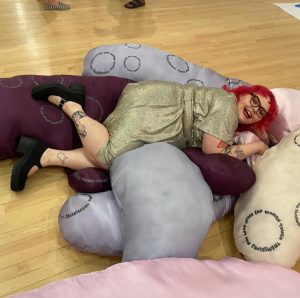By Lyra Bordelon
Greenbrier County native and current resident Kelsie Tyson has made waves in West Virginia with her art. Recently, the Tamarack Foundation granted Tyson one of its 2021 Emerging Artist Fellowships for her work celebrating body positivity, fat liberation, and Appalachia itself.
Held each year by the Tamarack Foundation for the Arts, the fellowship looks to highlight “thriving early-career artists” that “demonstrate not only a superior level of mastery in their craft, but also the aptitude to become successful professionals leading well-managed creative enterprises.”
Tyson is a Ronceverte native, a graduate of both Greenbrier East High School and Marshall University, current resident of Lewisburg and currently works for the Tamarack in Beckley. Her work highlights body positivity and Appalachia, showing both as something to be proud of and emboldened by.
“This is like the hardest thing,” Tyson joked after being asked to describe her art. “My work is all in the realm of fat liberation and body liberation. My research [also looks into] … the history of labor in Appalachia during the Industrial Revolution, specifically coal mining. People’s labor and their bodies were what helped, and still helps, keep things fast moving in other parts of the country, but then … we have West Virginia full of coal miners [who] are stereotyped as these lazy, ignorant, uneducated, fat-in-a-bad-way people. My work is [to] let people change their context of the word fat as an adjective [into] something they can describe themselves as, and be comfortable with, instead of this thing that they feel bad about being.”
One of her previous exhibits, “God Is Coming And They Are Fat,” featured massive pillows, each filled with 50 pounds of stuffing, shaped into F, A, and T, and covered in body positive messaging. Tyson explained her favorite works are larger than life, filling entire rooms.
“Most joy that sparks when I’m working is when I’m working with [materials that are] my size or bigger. … . I think about my younger self and I want to make work that is a celebration of body, even if I don’t always like myself or like my body. This is going to be bright and colorful, and say ‘Feed Ur Belly,’ ‘Hug Ur Belly,’ ‘Squeeze Ur Belly’ because that touch, feel, and taking care of your body is a part of accepting and being okay with existing in yourself.”
Tyson hopes to get in touch with a locality in Greenbrier County to create a mural celebrating the same themes as her previous works.

“I don’t like the white wall gallery in a museum, I don’t think my art will actually be doing anything in those grounds. There has to be some kind of activism in it, some kind of community engagement, or it’s just serving a certain kind of person instead of everybody. … Now what I want to be is creating a community of people who learn body acceptance and liberation and comfort in themselves. … Fat liberation, queer liberation, black liberation, all of those things are interconnected because oppessions aren’t separate from one another. They’re all related to the biggest thing, white supremacy.”
This even extends to the way people speak and write.
“I use a lot of slang words [in my work]. Instead of using to, I’ll use the number two regardless when I’m writing. Ur for your. A lot of it goes back to grad school – I had so many people [use big words] to describe things, but they don’t actually know what the words mean. … I think people classify the way words are written, if they’re misspelled, with someone being uneducated or ignorant or dumb, but it’s not. Those ideas … are part of how we exclude people from understanding what’s going on politically or what’s around them.”
During the interview with the Mountain Messenger, she explained that even as she knows and combats these “elitist” ideas about language, they still hold sway over her and the culture.
“Even now I’m not talking in my own voice because it’s an interview. I have this country accent and I taught myself to talk without it because I didn’t want to sound stupid, but then when I’m around my family, I talk like this,” Tyson said, the accent returning at the end.
As part of the fellowship, Tyson has been in touch with artists from across West Virginia. The Tamarack Foundation, and its executive director Renee Margocee, hopes the program will persuade more of the state’s youth to remain after graduation.
“It’s this big thing to help you make some work, network and establish yourself in West Virginia as an artist,” Tyson said. “I think Renee’s big vision is keeping young people and keeping artists in West Virginia. She just wrote this great opinion piece [in the Charleston Gazette-Mail] about how the arts are a way to save West Virginia.”
One major focus of the recently ended session of the West Virginia Legislature and Governor Jim Justice was seeking to keep young people in the state after they graduate, to build local communities. Margocee’s recent opinion piece highlights local art as one way to build these communities, a vision Tyson shares.
“Getting this made me realize how many people are working for that in West Virginia and it’s just a matter of us connecting together,” Tyson said. “It’s really exciting. I’m a first generation college student, so going to college was a big deal, then getting my Masters was a big deal, but I got these degrees in art. Most people want to be a doctor. … It’s a reaffirmation that being an artist was a good choice.
A collection of Tyson’s work, including “God Is Coming And They Are Fat,” can be found on her website, www.kelsietyson.com, alongside a number of smaller items available for purchase, such as earrings.



